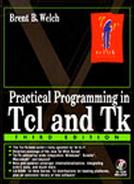- Copyright
- List of Examples
- List of Tables
- Preface
- Tcl Basics
- Tcl Fundamentals
- Getting Started
- The Guestbook CGI Application
- String Processing in Tcl
- Tcl Lists
- Control Structure Commands
- Procedures and Scope
- Tcl Arrays
- Working with Files and Programs
- Running Programs with exec
- The file Command
- Cross-Platform File Naming
- Manipulating Files and Directories
- File Attributes
- Input/Output Command Summary
- Opening Files for I/O
- Reading and Writing
- The Current Directory — cd and pwd
- Matching File Names with glob
- The exit and pid Commands
- Environment Variables
- The registry Command
- Advanced Tcl
- Tk Basics
- Tk Widgets
- Tk Details
- C Programming
- Changes
- Tcl 7.4/Tk 4.0
- wish
- Obsolete Features
- The cget Operation
- Input Focus Highlight
- Bindings
- Scrollbar Interface
- pack info
- Focus
- The send Command
- Internal Button Padding
- Radiobutton Value
- Entry Widget
- Menus
- Listboxes
- No geometry Attribute
- Text Widget
- Color Attributes
- Color Allocation and tk colormodel
- Canvas scrollincrement
- The Selection
- The bell Command
- Tcl 7.5/Tk 4.1
- Tcl 7.6/Tk 4.2
- Tcl/Tk 8.0
- The Tcl Compiler
- Namespaces
- Safe-Tcl
- New lsort
- tcl_precision Variable
- Year 2000 Convention
- Http Package
- Serial Line I/O
- Platform-Independent Fonts
- The tk scaling Command
- Application Embedding
- Native Menus and Menubars
- CDE Border Width
- Native Buttons and Scrollbars
- Images in Text Widgets
- No Errors from destroy
- grid rowconfigure
- The Patch Releases
- Tcl/Tk 8.1
- Tcl/Tk 8.2
- Tcl/Tk 8.3
- About The CD-ROM
- Tcl 7.4/Tk 4.0
- Index
Hello, World!
Example 1-1 The “Hello, World!” example.
puts stdout {Hello, World!}
=> Hello, World!
|
In this example, the command is puts, which takes two arguments: an I/O stream identifier and a string. puts writes the string to the I/O stream along with a trailing newline character. There are two points to emphasize:
Arguments are interpreted by the command. In the example, stdout is used to identify the standard output stream. The use of stdout as a name is a convention employed by puts and the other I/O commands. Also, stderr is used to identify the standard error output, and stdin is used to identify the standard input. Chapter 9 describes how to open other files for I/O.
Curly braces are used to group words together into a single argument. The puts command receives Hello, World! as its second argument.
The braces are syntax for the interpreter, and they get stripped off before the value is passed to the command. Braces group all characters, including newlines and nested braces, until a matching brace is found. Tcl also uses double quotes for grouping. Grouping arguments will be described in more detail later.
-
No Comment

